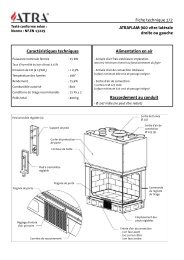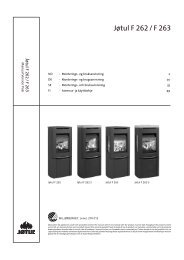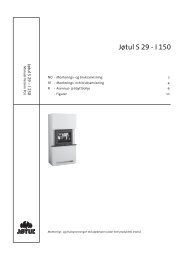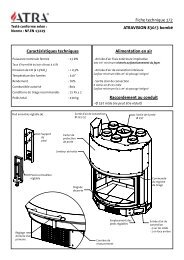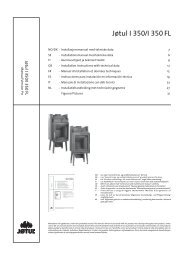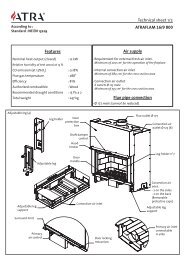Jøtul F 370 Series
Jøtul F 370 Series
Jøtul F 370 Series
Create successful ePaper yourself
Turn your PDF publications into a flip-book with our unique Google optimized e-Paper software.
English<br />
• Several solid fuel fired appliances can be connected to the<br />
same chimney if the chimney’s cross-section is sufficient.<br />
• Connection to the chimney must be carried out in accordance with<br />
the installation instructions from the supplier of the chimney.<br />
• Before making a hole in the chimney the fireplace should be<br />
test-mounted in order to correctly mark the position of the<br />
fireplace and the hole in the chimney. See fig. 1 for minimum<br />
dimensions.<br />
• Ensure that the flue pipe is inclined all the way up to the chimney.<br />
• Use a flue pipe bend with a sweeping hatch that allows it to<br />
be swept.<br />
Be aware of the fact that it is particularly important that<br />
connections have a certain flexibility in order to prevent<br />
movement in the installation leading to cracks.<br />
Chimney draught; See «2.0 Technical data». If the draught is<br />
too strong you can install and operate a flue damper to control<br />
the draught.<br />
Assembly of flue pipe with top outlet (fig. 18)<br />
The product is supplied from the factory with the smoke outlet<br />
mounted for top outlet.<br />
1. Put the top plate (fig. 18C) on the product.<br />
2. Obtain assistance in lifting the top grate (fig. 18A) and holding<br />
it up while the flue is fastened.<br />
3. Thread the flue pipe through the grate of the top plate and<br />
place it on the smoke outlet of the top outlet.<br />
4. Tighten well with gasket.<br />
Assembly of flue pipe with rear outlet<br />
(fig. 1, 3, 18 and 19)<br />
The product is supplied from the factory with the smoke<br />
outlet mounted for top outlet. If you want a rear outlet, do the<br />
following:<br />
1. Place the product in correct position (fig. 1).<br />
2. When changing to rear outlet, the smoke outlet (fig. 3B) is<br />
unscrewed from the top outlet.<br />
3. Unscrew the cover for the rear outlet from the inside of the<br />
burn chamber (fig. 3A).<br />
4. Place the gasket on the end of the flue pipe (fig. 19A).<br />
5. Mount the smoke outlet (fig. 19B) on the end of the flue pipe<br />
that is fitted with the gasket.<br />
6. Mount the flue pipe and smoke outlet from the inside of the burn<br />
chamber and attach the smoke outlet using M8x30 mm screws.<br />
N.B. If the flue pipe is longer than 350 mm it has to be assembled<br />
into the smoke outlet from the outside of the product.<br />
7. Fasten the cover to the top outlet (fig. 18) with the screws<br />
that fastened the smoke outlet.<br />
N.B. It is important that the joints/flue pipes are completely<br />
sealed. Air leaks can prevent the flue pipe from functioning<br />
properly.<br />
3.4 Mounting of the product -<br />
(fig. 20, 21 and 22)<br />
1. Place the baffle plate with the bar in the groove on the ribs<br />
(fig. 20A).<br />
2. Move the base plate through the opening and place it on<br />
the bottom.<br />
3. Place the riddling grate in position on the base plate. Check<br />
that the riddling grate’s slot on the right side is entered into<br />
the riddling bar (fig. 21A).<br />
4. Place the ash pan at the bottom of the product.<br />
5. Place the rear burn plate in the base plate’s rear groove.<br />
6. Place the side burn plates on each side in the base plate’s side<br />
grooves. Move the baffle plate in and place it so that it rests<br />
on the side and rear burn plates.<br />
7. Hold the baffle plate while the other side burn plate is<br />
mounted.<br />
8. Let the baffle plate rest on the burn plates.<br />
9. Place the small side burn plates (fig. 22 A) in the base plate’s<br />
groove under the side glasses.<br />
10. Replace the top plate with the top grid and bowl.<br />
11. Place the product data plate which is in the ash pan,<br />
underneath the burn chamber.<br />
3.5 Control of functions (fig. 23)<br />
When the product is set up, always check the control functions.<br />
These shall move easily and function satisfactorily.<br />
Jøtul F <strong>370</strong> is equipped with the following controls:<br />
Air vent fig. 23A<br />
Left position: Closed<br />
Right position: Open<br />
Ignition vent, fig. 23B)<br />
Pushed in: Closed<br />
Pulled out: Open<br />
Riddling grate (same handle as for the ignition vent) (Fig. 23B)<br />
Right handle is pushed in and out.<br />
Handle for door fig. 23C:<br />
Is opened by pulling handle out.<br />
3.6 Ash removal<br />
Jøtul F <strong>370</strong> has an ash pan which makes it easy to remove the ashes.<br />
1. Only remove ashes when the fireplace is cold.<br />
2. Push/pull the handle for the ash grate/ignition vent out and in<br />
several times so that the ashes fall down into the ash pan. Use<br />
something like a glove to grab the handle on the ash pan.<br />
3. Make sure that the ash pan doesn’t fill up so high that it keeps<br />
ash from coming through the grate into the pan.<br />
4. Make sure the door to the ash pan is securely shut when the<br />
stove is in use.<br />
For the rest, see description of how to handle ash in the Manual<br />
on general use and maintenance in Point «6.1 Fire preventive<br />
measures».<br />
3.7 Use (fig. 23)<br />
• Open the air vent and the ignition vent by pulling it<br />
out all the way. If necessary, keep the door slightly open.<br />
(Use a glove, for example, as the handle can become hot.)<br />
• Place two medium sized logs in/out on each side of the base.<br />
N.B. In order to avoid sooting on the glass, it is important that<br />
the log is not placed adjacent to the glass on the product.<br />
• Crumple some newspaper (or birch bark) between these and<br />
add some kindling wood in a criss-cross pattern on top and<br />
light the newspaper.<br />
• Gradually increase the size of the fire, but the wood should<br />
not be stacked higher than the horizontal holes on the back<br />
burn plate. See fig. 23H.<br />
• Close the ignition vent (fig. 23 B) when the firewood has<br />
ignited and the fire is burning well.<br />
• Check that the afterburning (secondary combustion) starts. This<br />
is best indicated by yellow, flickering flames under the baffle.<br />
• Then regulate the rate of combustion to the desired level of<br />
heating by adjusting the air vent (fig. 23A).<br />
See the general manual for information regarding use of the<br />
stove.<br />
25



